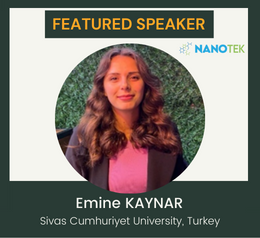Scholars Frontiers in
Nanoscience and Nanotechnology Congress
THEME: "Fostering Advancements in Nanoscience and Nanotechnology"
 27-28 Mar 2023
27-28 Mar 2023  Crowne Plaza Ealing, London, UK & Online
Crowne Plaza Ealing, London, UK & Online THEME: "Fostering Advancements in Nanoscience and Nanotechnology"
 27-28 Mar 2023
27-28 Mar 2023  Crowne Plaza Ealing, London, UK & Online
Crowne Plaza Ealing, London, UK & Online 
Sivas Cumhuriyet University, Turkey
Title: Investigation on AlN/Si Distributed Bragg Reflector for VECSELs at Telecom Wavelengths
Emine Kaynar, after completing her
undergraduate education in nanotechnology engineering, is doing her master's
degree in the same department. She is actively working at the Nanophotonics
Application and Research Center during master’s degree education. While working
at this center, she worked in projects named Growth and Characterization of
AlN/Si Distributed Bragg Reflector, Numerical Investigation of Diffraction
Patterns of Small-sized Apertures Using XUV Region to Visible Region Light Sources,
and Determination of Structural and Optical Properties of InP/InGaAs Structure
Grown at Different As Concentrations by Metal Organic Chemical Vapor Deposition
Method. She wrote articles named Determination of Optical Properties of MOVPE-Growth
InxGa1-xAs/InP Epitaxial Structures by Spectroscopic Ellipsometry, Sputtered
AlN for Distributed Bragg Reflectors Operating in the SWIR Wavelengths and The
effect of structure parameters and static electric field on the nonlinear
optical properties of triple InGaAs/GaAs during the master’s degree education. She
also participated in congress named Advanced Photonics Congress (OPTICA).
The use of semiconductor-based electronic and optoelectronic devices takes more and more in daily life. One of the semiconductor-based device research areas has been surface-emitting lasers. Vertical external cavity surface emitting lasers (VECSELs) have been extensively studied in the literature because they can be used in fiber optic networks and optical interconnects. The optically pumped VECSEL offers many potential advantages over a conventional in-plane laser. One of these advantages is the compatibility of VECSEL chips with low-cost substrate scale fabrication and testing methods. The near-infrared region was the focus of the first VECSEL studies. Since the first demonstration, 100 W continuous wave power and pulse width less than96 fs at GHz level correspond to kW level peak powers in single mode lasing have been obtained at 1 ?m wavelength by using GaAs-based VECSEL. However, GaAs-based VECSEL performances could not be obtained in the rest of the electromagnetic spectrum. There are two main reasons for this: low thermal conductivity and refractive index difference of the used materials.
Based on these studies, it is aimed to eliminate the problems of thermal conductivity and refractive index difference in this study. For this purpose, a new material system has been developed and 6 pairs of high thermal conductivity (kThSi=180 W/cm.K, kThAlN=300W/cm.K) and high refractive index difference (nSi=3.6, nAlN=2.25)Si/AlN DBR structure has been grown on the Si substrate by using sputtering technique. Then, structural and optical characterization of AlN/Si DBR structure has been performed. Optical characterization of the DBR has shown reflection of more than 99% for the 6-pair.